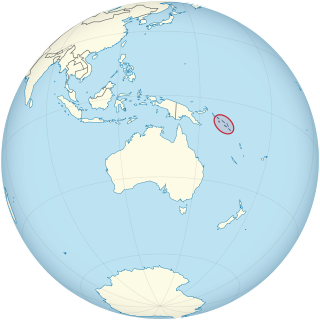
The Vought F4U Corsair is an American fighter aircraft which saw service primarily in World War II and the Korean War. Designed and initially manufactured by Chance Vought, the Corsair was soon in great demand; additional production contracts were given to Goodyear, whose Corsairs were designated FG, and Brewster, designated F3A.
Nissan Island Airport is an airfield serving Nissan Island, in the Autonomous Region of Bougainville in Papua New Guinea. It resides at an elevation of 100 feet (30 m) above mean sea level and has a 1,200-metre (3,937 ft) runway designated 14/32.
Munda Airport is an international airport adjacent to the town of Munda, Western Province in Solomon Islands.

Seghe Airport is an airport on Seghe in the Solomon Islands.

Hawkins Field is a former World War II airfield on Betio, Tarawa in the Gilbert Islands of the Central Pacific.
Nukufetau Airfield is a former World War II airfield on the south-eastern side of Nukufetau on Motulalo Island in Tuvalu during the Pacific War.
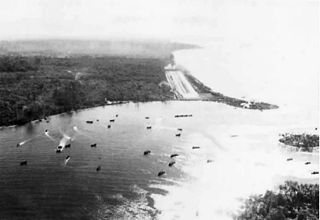
Torokina Airfield, also known as Cape Torokina Airfield, is a former World War II airfield located at Cape Torokina, Bougainville.
Emirau Airport is an airfield in Emirau Island, Papua New Guinea.

Palikulo Bay Airfield or Bomber Field #1 is a former World War II airfield on the island of Espiritu Santo in the New Hebrides Islands at the Espiritu Santo Naval Base.

Turtle Bay Airfield or Fighter Field #1 is a former World War II airfield on the island of Espiritu Santo in the New Hebrides Islands at the Espiritu Santo Naval Base.

Nanumea Airfield is a former World War II airfield on the island of Nanumea in the Ellice Islands.
Piva Airfield is a former World War II airfield on Bougainville Island in the Solomon Islands archipelago.
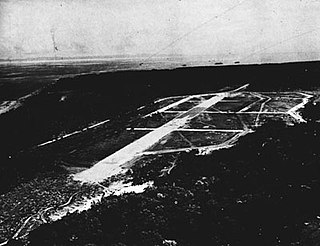
Kukum Field also known as Fighter 2 Airfield is a former World War II airfield on Guadalcanal, Solomon Islands.
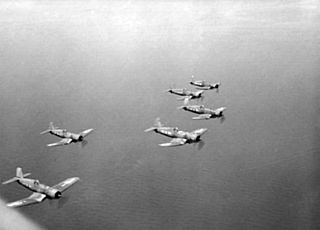
No. 18 Squadron was a squadron of the Royal New Zealand Air Force. Formed in June 1943 at RNZAF Base Woodbourne, the squadron was initially equipped with Curtiss P-40 Kittyhawks, before converting to F4U-1 Corsair fighter bombers in 1944. The squadron fought in the Pacific theatre during World War II, flying combat operations against Japanese forces until it was disbanded in late 1945.

Barakoma Airfield is a former World War II airfield on Vella Lavella in the Solomon Islands archipelago.

Segi Point Airfield is a former World War II airfield on New Georgia in the Solomon Islands archipelago.
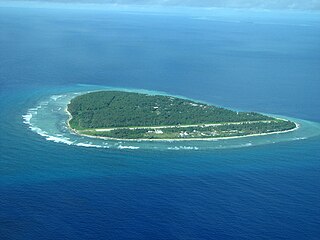
Ulithi Civil Airfield is a public airport serving the island of Falalop, located in the Ulithi Atoll in the Caroline Islands, Federated States of Micronesia. It was previously Falalop Airfield or Naval Air Base Ulithi, when used as a World War II airfield.
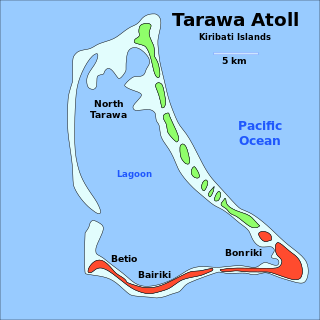
Naval Base Tarawa was a naval base built by the United States Navy in 1943 to support the World War II effort. The base was located on Tarawa atoll in the Gilbert Islands in the Central Pacific Ocean. The base was built as one of many advance bases in the island-hopping campaign towards the Empire of Japan. At Naval Base Tarawa the Navy built a seaport, seaplane base and two airbases. Construction started after the Battle of Tarawa ended November 23, 1943, part of Operation Galvanic.

Naval Base Abemama was a naval base built by the United States Navy in 1943 to support the World War II effort. The base was located on Abemama atoll, also called Hopper Atoll, in the Gilbert Islands in the Central Pacific Ocean. The base was built as one of many advance bases in the island-hopping campaign towards the Empire of Japan. At Naval Base Abemama the Navy built a seaport and airbase. Construction started after the Battle of Abemama ended November 24, 1943, part of Operation Galvanic.














